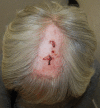Erosive pustular dermatosis of the scalp: challenges and solutions
- PMID: 31571969
- PMCID: PMC6747878
- DOI: 10.2147/CCID.S223317
Erosive pustular dermatosis of the scalp: challenges and solutions
Abstract
Erosive pustular dermatosis of the scalp is a rare chronic inflammatory disorder defined. It usually affects elderly people and is characterized by extensive pustular lesions, erosions, and crusts located on the scalp. The pathogenesis of this disease is not completely understood, but a known predisposing factor is skin trauma. Autoimmune disorders including rheumatoid arthritis, autoimmune hepatitis, Hashimoto thyroiditis, and Takayasu aortitis are associated diseases reported. The clinical examination reveals erythema, erosions, crusts, follicular pustules, and in advanced stages, scarring alopecia. A scalp biopsy is recommended but not specific, founding epidermal atrophy, focal erosions, and a mixed inflammatory infiltrate consisting of neutrophils, lymphocytes, and plasma cells. Bacterial cultures, fungal and viral stains are not necessary and are usually negative. . Topical high-potency corticosteroids, retinoids, calcipotriol, dapsone, and topical tacrolimus are reported treatments, while photodynamic therapy has been effective in some patients, but has induced the disease in others. All the findings are suggestive but not specific, so it is an excluding diagnosis. The combination of predisposing factors is very important for a correct diagnosis, such as elderly age, sun-damaged skin, presence of androgenetic alopecia, together with clinical manifestations, non-specific histology and laboratory investigations negative for other disease. In our opinion, this scalp disease is a challenge for the dermatologist. We review all the literature to better define the possible solutions in case of suspected erosive pustular dermatosis of the scalp.
Keywords: cicatricial alopecia; scalp erosions; scalp trauma; scarring alopecia; trichoscopy.
© 2019 Starace et al.
Conflict of interest statement
The authors report no conflicts of interest in this work.
Figures








Similar articles
-
Erosive pustular dermatosis of the scalp: a multicentre study.J Eur Acad Dermatol Venereol. 2020 Jun;34(6):1348-1354. doi: 10.1111/jdv.16211. Epub 2020 Feb 9. J Eur Acad Dermatol Venereol. 2020. PMID: 31954062
-
Erosive pustular dermatosis of the scalp and multiple sclerosis: just a coincidence?Dermatol Reports. 2022 Nov 21;14(4):9445. doi: 10.4081/dr.2022.9445. eCollection 2022 Nov 21. Dermatol Reports. 2022. PMID: 36483234 Free PMC article.
-
Erosive pustular dermatosis of the scalp following herpes zoster: successful treatment with topical tacrolimus.Ann Dermatol. 2010 May;22(2):232-4. doi: 10.5021/ad.2010.22.2.232. Epub 2010 May 18. Ann Dermatol. 2010. PMID: 20548924 Free PMC article.
-
Treatment of erosive pustular dermatosis of the scalp: our experience and review of unconventional topical drugs.Eur Rev Med Pharmacol Sci. 2023 Feb;27(3):1023-1026. doi: 10.26355/eurrev_202302_31197. Eur Rev Med Pharmacol Sci. 2023. PMID: 36808348 Review.
-
Erosive pustular dermatosis of the scalp: causes and treatments.Int J Dermatol. 2021 Jan;60(1):25-32. doi: 10.1111/ijd.14955. Epub 2020 Jun 9. Int J Dermatol. 2021. PMID: 32516510 Review.
Cited by
-
Erosive Pustular Dermatosis of the Scalp in a Patient With Vitiligo Successfully Treated With Topical Antibiotics.Cureus. 2023 Sep 25;15(9):e45913. doi: 10.7759/cureus.45913. eCollection 2023 Sep. Cureus. 2023. PMID: 37885526 Free PMC article.
-
A case of treatment-resistant erosive pustular dermatosis of the scalp.SAGE Open Med Case Rep. 2025 Jan 2;13:2050313X241307126. doi: 10.1177/2050313X241307126. eCollection 2025. SAGE Open Med Case Rep. 2025. PMID: 39758191 Free PMC article.
-
Erosive pustular dermatosis-like eruption of the scalp secondary to amivantamab: A case series.JAAD Case Rep. 2024 Jan 17;47:72-79. doi: 10.1016/j.jdcr.2023.11.027. eCollection 2024 May. JAAD Case Rep. 2024. PMID: 38659476 Free PMC article. No abstract available.
-
Dermoscopic Features of Erosive Pustular Dermatosis of the Scalp: A Comparative Multicentric Retrospective Study in Bald and Hairy Patients.Clin Cosmet Investig Dermatol. 2025 Mar 20;18:669-676. doi: 10.2147/CCID.S514416. eCollection 2025. Clin Cosmet Investig Dermatol. 2025. PMID: 40134613 Free PMC article.
-
Erosive Pustular Dermatosis: Delving into Etiopathogenesis and Management.Life (Basel). 2022 Dec 13;12(12):2097. doi: 10.3390/life12122097. Life (Basel). 2022. PMID: 36556462 Free PMC article. Review.
References
-
- Burton JL. Case for diagnosis. Pustular dermatosis of the scalp. Br J Dermatol. 1977;97 Suppl:15-67-9. - PubMed
LinkOut - more resources
Full Text Sources
Other Literature Sources

